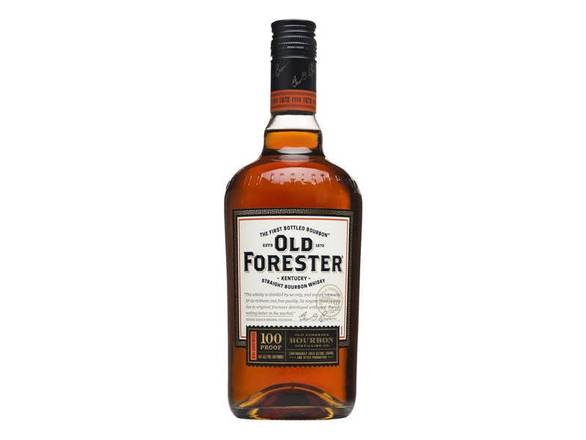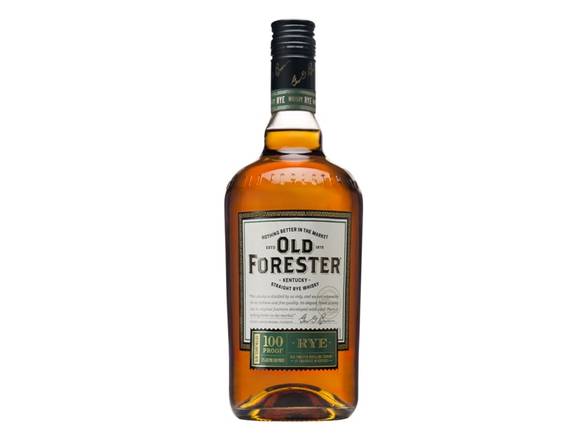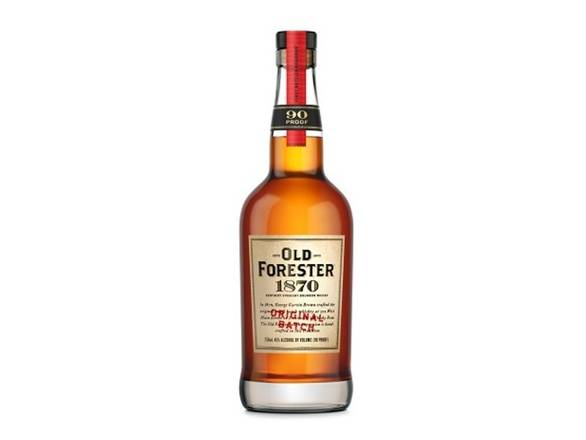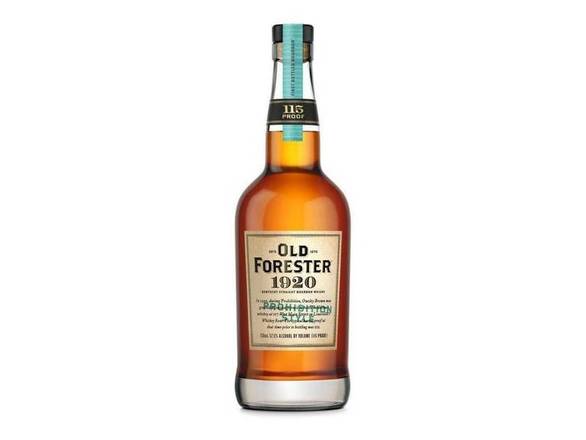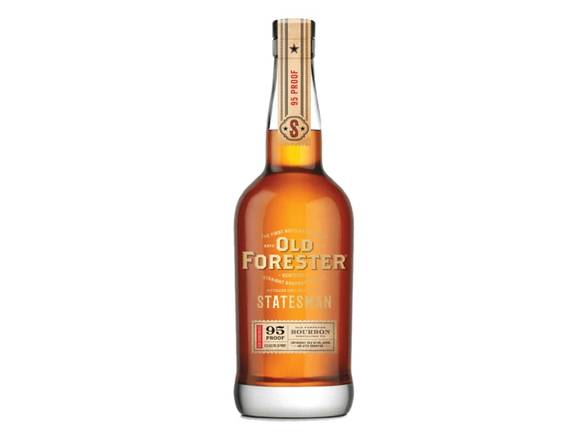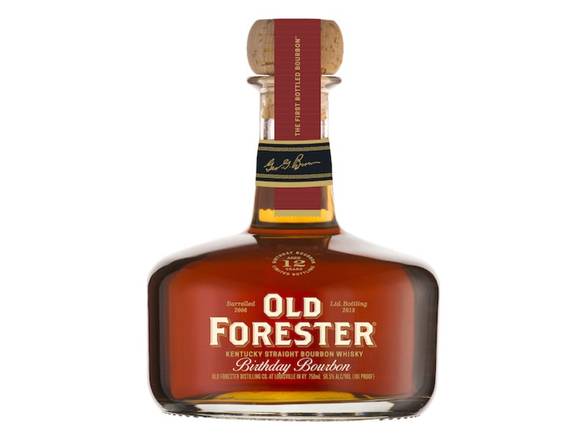Old Forester
Kentucky Straight Bourbon Whisky
July 18, 2021
History
George Garvin Brown was born in Munfordville, Kentucky, on September 2, 1846, educated in Louisville, and began working at the wholesale drug company, Henry Chambers & Co. While working as a pharmaceutical rep, Brown noticed that doctors were consistently complaining about the unreliable quality of current medical whiskies. Now, keep in mind this was the mid-1800s, and medicinal Whiskey was very much an essential tool for doctors. That led Brown to create his Whiskey in 1870, a blend of whiskey from three different local distilleries. Brown’s Whiskey was the first American Whiskey to be sold commercially in individually packaged and sealed bottles to ensure consumers of its quality. The trademarked phrase, “The First Bottled Bourbon,” still appears on each bottle of Old Forester.
Dr. William Forrester, spelled with two Rs, was a well-known doctor in Louisville that allowed his name to be used on the label to signify the Whiskey’s consistency and quality. When Dr. Forrester retired, the second R was dropped from the brand’s name, and Old Forester, spelled with one R, is still spelled the same way today.
Besides being “The First Bottled Bourbon,” Old Forester’s other significant claim to fame is being one of six Kentucky distilleries to legally produce Whiskey under a medicinal license during the thirteen years of Prohibition. If this subject interests you, check out Chuck Cowdery’s article about Medicinal Whiskey production during Prohibition. His blog is an incredible resource for anyone who wants to go down a rabbit hole on exciting topics in the world of American Whiskey.
Thanks to Owsley Brown, the son of George Garvin Brown, Brown-Forman is the only one of those six companies that still exist today, and there is still a member of the Brown family leading the organization. Old Forester remains the only bourbon brand continuously sold by the same company, before, during, and after Prohibition.
When it comes to talking about Old Forester’s parent company Brown-Forman, it doesn’t take long before the topic of barrels comes up. Brown-Forman is one, if not the only, spirits supplier that owns and operates their cooperages. This dates back to 1945 when Brown-Forman purchased a furniture company and created the Bluegrass Cooperage to make custom bourbon barrels. The first barrel was produced in 1946, and the company is now the Brown-Forman Cooperage. It is the company’s goal to own the entire whiskey-making process from distillation, maturation to bottling. Since the vast majority of Whiskey’s flavor and all of its color comes from the barrel, it’s clear why barrel making is vital to Brown-Forman.
The majority of commercially available Old Forester is produced at the Brown-Forman Distillery near Dixie Highway in Shively, Kentucky. The new Old Forester Distillery on historic whiskey row in downtown Louisville is a $45 million, 70,000 square foot, fully operational and active distillery. This facility has a 24” Vendome beer that will distill 100,000 proof gallons of Whiskey per year and process 4,500 gallons of mash per day. The facility even has a fully operational cooperage with a capacity of 26 barrels per day. The on-site warehouse will age up to 900 barrels, and the remaining barrels will be aged at Brown-Forman Distillery. If you’re in Louisville, I highly recommend touring the new facility. It’s definitely worth the time!
Photo by Brian Donnelly
Photo by Brian Donnelly
Photo by Brian Donnelly
Photo by Brian Donnelly
Production
Ok, let's examine the production process behind the Old Forester brand. All expressions, except the rye, have the same mash bill:
72% Corn, 18% Rye, and 10% Malted Barley
If you're unfamiliar with the term mash bill, it simply the proportion of grains from which the whiskey is fermented and distilled. Without getting too technical, Bourbon is typically produced from a mash bill of corn, rye, and malted barley, unless it's a wheated Bourbon, like Maker's Mark or Weller, that swaps out the rye for wheat. One of the many legally defining rules for Bourbon is that it is produced from a mash of at least 51% corn, but usually, the percentage of corn is much higher. I'll go into more detail about the legal specifications for Bourbon, Rye, and Tennessee Whiskey in a later video.
Next, let's talk about water because it is a critical flavor building block, just like the mash bill. Old Forester uses purified water to proof down their whiskey before maturation and before bottling. Like Brown-Forman's other famous Bourbon brand Woodford Reserve, many Kentucky Bourbon brands use limestone-filtered spring water as their water of choice. This is because this water is full of rich minerals, such as magnesium, zinc, and potassium, vital for the fermentation process. Plus, the limestone naturally filtered out iron because it could ruin the flavor of the Bourbon. Water is used consistently throughout the whiskey production process, so this is one of many decisions the producer can make to dial their final desired flavor profile.
A brand's "recipe" is the combination of its signature mash bill and proprietary yeast strain. Old Forester uses a proprietary yeast strain called 1B with about 20% sour mash, and it is used exclusively for Old Forester. If you're unfamiliar with sour mashing, sometimes referred to as backset, it is a technique used to increase the liquid's acidity that will be fermented by adding the acidic residue that comes out of the base of the beer still after distillation. The fermentation process for Old Forester usually lasts between 3 and 5 days, which seems relatively standard for the category. Like Woodford Reserve and Cooper's Craft, the other brands that Master Distiller Chris Morris oversees each have their own "recipe" with a proprietary yeast strain. This is because these two components will give the end product a noticeably different flavor profile. It allows producers to build that flavor profile block by block throughout the production process.
Next, Old Forester is double distilled in a copper column beer made by Vendome Copper & Brass in Louisville, who make almost all the stills used in the commercial Bourbon industry. The new make spirit, or white dog, comes off the still at 140 proof, or 70% ABV, and is cut to 125 proof, or 62.5% ABV, before entering the charred new American white oak barrel. We have already talked about the importance Brown-Forman places on their barrels. All barrels used for the Old Forester brand will come exclusively from one of the Brown-Forman Cooperages. Old Forester, along with Woodford Reserves, both age their barrels in temperature-controlled warehouses. This technique is credited to Colonel E.H. Taylor Jr., who invented the technology of steam-heated cycled rack houses. Most Kentucky distillers do not heat-cycle their aging facilities, instead they use traditional open-air rack houses, which are hot in the summer and cold in the winter. I will explain the different maturation techniques used for each expression when I explain each product in the family of brands.
Photo by Brian Donnelly
Photo by Brian Donnelly
Old Forester Core Series
The Old Forester core line-up includes the 86, 100, and Rye. The 86 is the entry-level expression in the brand line-up and won my pick for the best Bourbon under $20. I did an analytical tasting of 14 Bourbons and found the Old Forester 86 to be the best option under $20 hands-down. The 86 and the 100 are named for their bottling proofs, and both make fantastic cocktail Bourbons. Both expressions give consumers a lot of value for the money.
The Rye is a relatively new expression from Old Forester. It has a mash bill of 65% Rye, 15% Corn, and 20% Malted Barley. The brand reintroduced a historic rye recipe from the Normandy Rye Whiskey brand, acquired in 1940 by former Brown-Forman President Owsley Brown. Lined price with the Old Forester 100 proof, this product is one of the most fantastic American Rye whiskies at this price point. Unfortunately, Brown-Forman underestimated just how popular this product would be, and demand quickly exceeding supply, so the company had to allocate this product in most major markets. This product is bottled at 100 proof, or 50% ABV.
Old Forester Whiskey Row Series
Photo by Brown-Forman (BAR+)
The Old Forester Whiskey Row Series represents important and milestone events in the brand’s history, which also parallels the history of the modern Bourbon industry. Now let’s taste through history.
Old Forester 1870 Original Batch
The Old Forester 1870 Original Batch is the first expression in the Whiskey Row series. This expression echoes the quality and consistency of George Garvin Brown’s original bottled Bourbon in 1870. Brown achieved quality by being the first person to sell his whiskey exclusively in a sealed glass bottle. He reached consistency by sourcing his whiskey from three different distilleries and blended the three to achieve a consistent product every time.
To emulate the original batching process from 1870, seven barrels are each selected from three different warehouses, then mingled together. Similar to the process that would have been available to Brown, this expression is minimally filtered and bottled at 90 proof, or 45% ABV.
Old Forester 1879 Bottled-in-Bond
The Old Forester 1879 Bottled-in-Bond expression mingles fewer than 100 barrels and pays homage to the US Bottled-in-Bond Act of 1879. But what exactly does Bottled-in-Bond mean? Qualifying whiskey must be from a single distillery, and the bottled product must come from the same distilling season, either January 1st to June 30th or July 1st to December 31st. It must be aged for at least four years in wood containers and bottled at 100 proof, or 50% ABV. This is a labeling term frequently seen on whiskey labels, but it is not limited to whiskey. Other spirit categories can also be labeled bottled-in-bond.
The risk of buying rotgut whiskey made from neutral grain spirits and tobacco juice is no longer a threat to consumers. However, Bottled-in-Bond's labeling term still reassures consumers that the product they're purchasing meets a base standard of quality.
In my "Best Bourbon Series," I choose Old Forester 1879 as the best Bourbon between $40 and $50, from a competitive set of ten great Bourbons.
Old Forester 1910 Old Fine Whiskey
The newest expression in the Whiskey Row Series is the 1910 Old Fine Whiskey. In October of 1910, a fire broke out on Whiskey Row and caused the Old Forester to shut down in the middle of bottling. The distillery had a tank of fully matured 100 proof whiskey that could not be bottled when the distillery felt that product was ready. Instead, they aged the whiskey in a second, new, heavily charred barrel and sold it as a product called Very Old Fine Whiskey.
Brown-Forman claims this is the first documented double-barreled bourbon. According to Old Forester’s Master Taster, Jackie Zykan, “A standard Old Forester barrel receives about a 22-second char, while the second barrel used in 1910 receives more than double that, about 50 seconds. The bourbon is rested between 7 and 9 months in this second barrel. This product is bottled at 93 proof, 46.5% ABV.
Old Forester 1920 Prohibition Style
Old Forester 1920 Prohibition Style was the third release in the Whiskey Row series and paid tribute to another important event in Bourbon’s history. The Volstead Act of 1920 initiated the thirteen years of Prohibition. While the commercial production of alcohol was prohibited, Old Forester was one of six Kentucky distilleries that could legally produce whiskey under a medicinal license. The distillery held Kentucky permit #3. At this time, the barrel entry proof for Old Forester was 100 proof. During the maturation process, the evaporation, or “Angel’s Share,” increased the aging whiskey’s barrel proof, which ended up around 115 proof, or 57.5% ABV. This expression is minimally filtered for maximum flavor and represents a vintage example of barrel-strength whiskey.
Beyond Whiskey Row
Old Forester Statesman
The Old Forester Statesman is perhaps the best value and least known option in the family of brands. The brand came from a partnership between Brown-Forman and 20th Century Fox for the 2017 film sequel: Kingsman: The Golden Circle. The barrels used for this expression are hand-selected from the warmest parts of the rack house. Since Old Forester heat cycles their rack houses, the barrels age in uniform conditions, but some secret hot spots yield intense character and bold flavor. In my “Best Bourbon Series,” the Statesman was one of my top picks of Bourbons between $50 and $75. This product is bottled at 95 proof, or 47.5% ABV.
Old Forester Birthday Bourbon
Finally, the Old Forester Birthday Bourbon is the last and most highly coveted member in the family of brands. First released in 2002, this highly limited expression is released annually on September 2nd to celebrate the birthday of George Garvin Brown, the brand’s founder. Master Distiller Chris Morris and Master Taster Jackie Zykan hand-select older barrels that show exceptional character during a tasting panel. The age statement and bottling proof will vary each year. I will link Old Forester’s website below with detailed information on each year’s Birthday Bourbon release.
Closing Thoughts
Thanks to the trifecta of Brown-Forman, Master Distiller Chris Morris, and Master Tasting Jackie Zykan, Old Forester continues to deliver history, value, and innovation to their customers and raise the bar for the entire Bourbon category. In the words of George Garvin Brown, “There is nothing better in the market.”
Please Drink Responsibly.
Photo by Brian Donnelly
Photo by Brian Donnelly
Support The Spirits Educator
If you would like to support the content here, please click the button below to buy me a cocktail or neat pour through PayPal. You can also use Venmo @thespiritseducator.
Thank you for your support!
Affiliate Disclosure
The links for product recommendations in this post are affiliate links. At zero cost to you, I will earn an affiliate commission if you click through the link and finalize a purchase. This helps support this channel so that I can continue to bring you new content.








